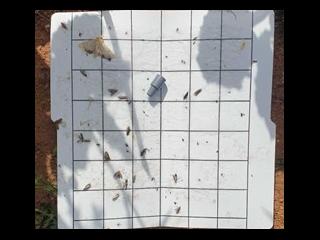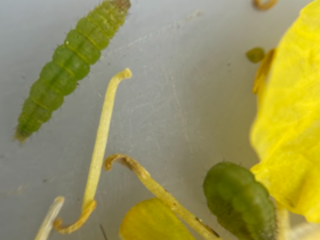Diamondback moth numbers are low, but growers are reminded to monitor with warming temperatures
- Geraldton
- Northam
- Mukinbudin
- Scaddan

Low numbers of diamondback moth (DBM) have been detected in canola focus crops across the grainbelt as part of the Grains Research and Development Corporation (GRDC) DBM surveillance program.
The shire of Northam had the highest number of DBM moths captured in pheromone-baited traps over the last month with 46 moths, followed by Scaddan with 43, Mukinbudin with 22 and Geraldton with 18. In most traps, fewer than 10 moths were captured in a month. These low numbers differ from the same period last year, when the average number of moths per trap per month across the grainbelt area was 98 in July and 177 in August 2022. Notably higher numbers were captured in localised parts of the eastern grainbelt during August, which resulted in larvae increasing to above threshold levels fairly early and requiring spraying.

The DBM pheromone trap program is being conducted to gather data to better understand the drivers of DBM outbreaks in WA. Additionally, it provides an early indication of potential larvae build-up following increases in moth numbers detected. This early warning allows growers and agronomists to target their efforts in sweep netting crops, which is laborious and difficult in tall crops.

The DBM surveillance program is part of a GRDC-funded project and conducted by Department of Primary Industries and Regional Development (DPIRD) staff along with grower groups (Mingenew Irwin Group, West Midlands Group, Facey Group and Liebe Group) and South East Agronomy Research (SEAR) based at Esperance. Widespread surveillance occurs fortnightly throughout the season in 46 focus crops located across the grainbelt. Pheromone-baited delta traps are used to monitor DBM and sweep netting is undertaken to monitor larvae. The surveillance team will continue to provide regular updates to growers and consultants throughout the season via the PestFacts WA eNewsletter.
Diamondback moth caterpillars
- Mingenew
- Northam

DBM caterpillars are usually pale yellowish green and tapered at each end of their body and grow to about 10 mm long. They often wriggle rapidly when disturbed and will hang on a silken thread. For more information, refer to DPIRD’s diagnosing diamondback moth page.
DBM larvae have not been detected at canola focus crops in the past fortnight apart from a single caterpillar at a Mingenew monitoring site, which confirms that low moth numbers during June and July have resulted in very low larvae numbers overall.
In July, Research Scientist Amber Balfour-Cunningham (DPIRD) reported below threshold numbers of larvae in sweeps of unsprayed early flowering canola at a Northam DPIRD field trial site. There have been no other reports into DPIRD regarding DBM larvae this season.
Monitoring and management
Despite low numbers of DBM being found so far this season, growers and consultants should begin their monitoring soon by doing at least four lots of ten sweeps with an insect net at various locations in each canola crop. Monitoring may assist with foreseeing possible damaging populations in spring when DBM activity usually ramps up.
DPIRD's Seasonal Climate Outlook report is predicting high chances of warmer temperatures and reduced rainfall for the August to October period. Canola plants are more vulnerable to caterpillar damage when they are stressed due to dry conditions and when they are closer to flowering.
If you are sweep netting canola crops for DBM caterpillars please use the PestFacts WA Reporter app to report your findings. It will help DPIRD’s DBM surveillance project team to determine how well the pheromone traps have worked in predicting outbreak risk and trigger crop protection programs before economic damage occurs.
When making the decision of whether to apply an insecticide, the DBM thresholds for flowering canola are:
- Early to mid flowering (no moisture stress) - 50 caterpillars or more per 10 sweeps
- Mid to late flowering (no moisture stress) - 100 or more caterpillars per 10 sweeps.
Some other helpful tips to consider when sweep netting crops are:
- A high proportion of small grubs (less than 3 mm) in a sample often indicates that numbers will increase further.
- Regular assessments of the number of grubs in the crop are required. This is because the numbers can fluctuate and are just as likely to decrease as they are to increase at any stage throughout the growing season. Grub numbers may reduce in cool, wet and windy conditions or fine and mild weather.
- When checking crops with a sweep net, be mindful that small native budworm caterpillars can easily be confused with DBM caterpillars in canola crops. Native budworm caterpillars are far more damaging as they grow to larger sizes (up to 40mm long) and will chew into the pods.
New product registered for diamondback moth in canola
Growers and agronomists should be aware that the active ingredient cyantraniliprole is now registered for use on DBM in canola.
Pesticide options for the control of DBM can be found in DPIRD’s 2023 Winter Spring Insecticide Guide.
More information
For more DBM information refer to:
- DPIRD’s Diagnosing diamondback moth page
- GRDC's Diamondback moth fact sheet
- GRDC’s Managing diamondback moth video.
For more information contact Research Scientist Svetlana Micic in Albany on +61 (0)8 9892 8591 or Technical Officer Alan Lord in South Perth on +61 (0)8 9368 3758.
Article authors: Bec Severtson (DPIRD Northam) and Christiaan Valentine (DPIRD Northam).
